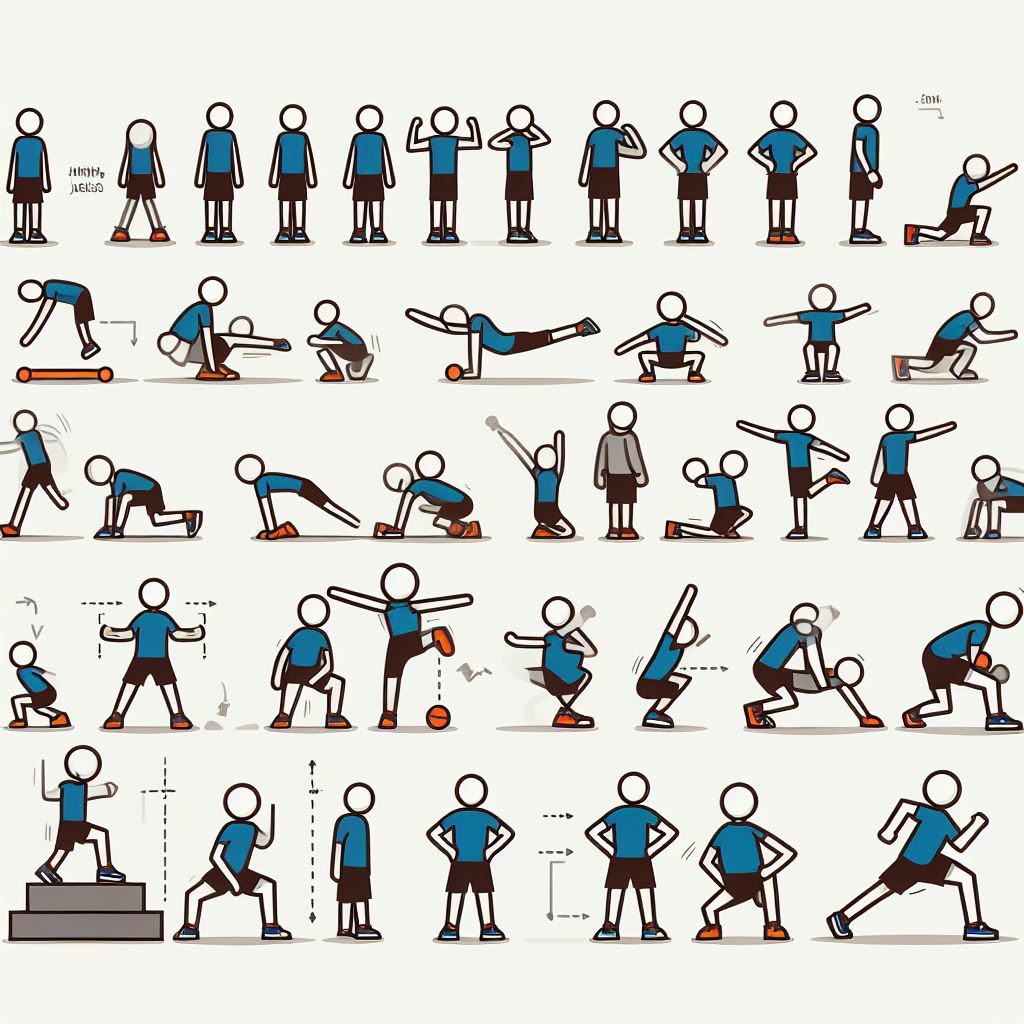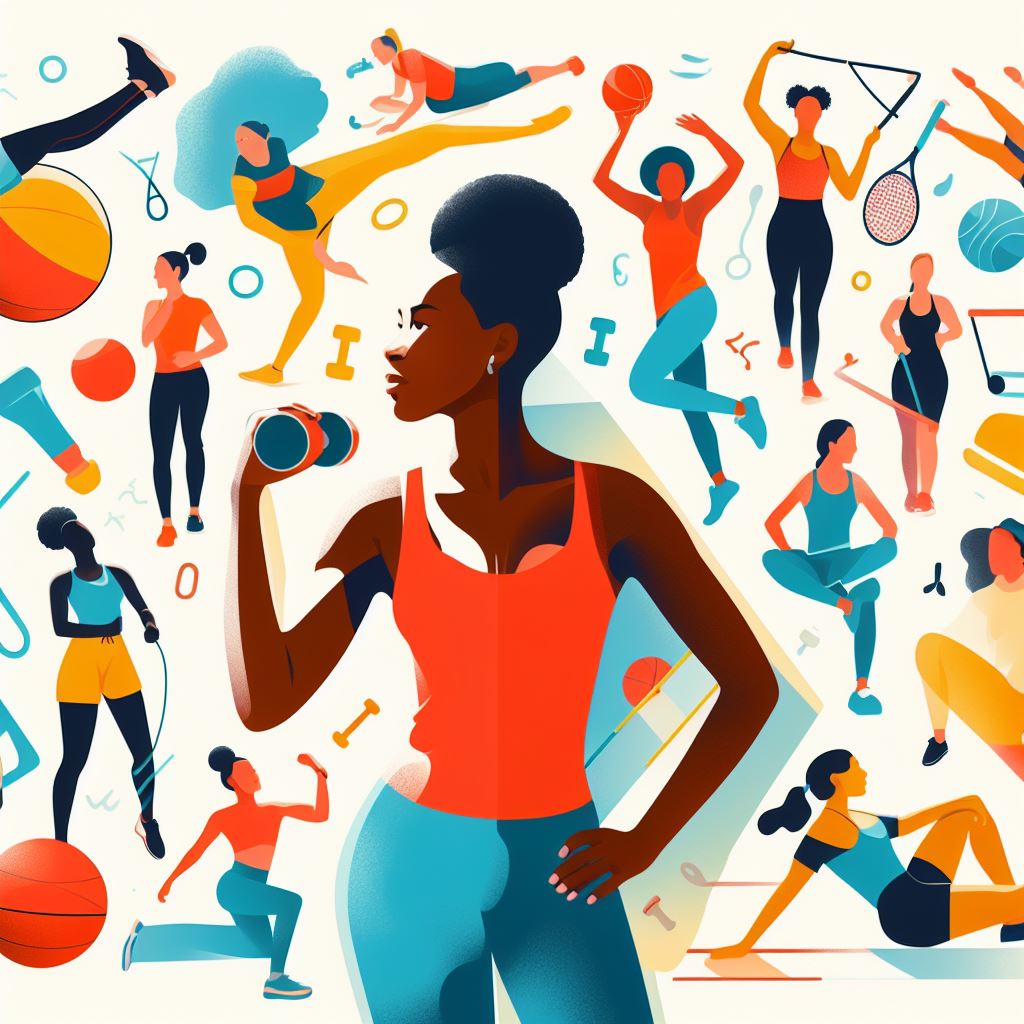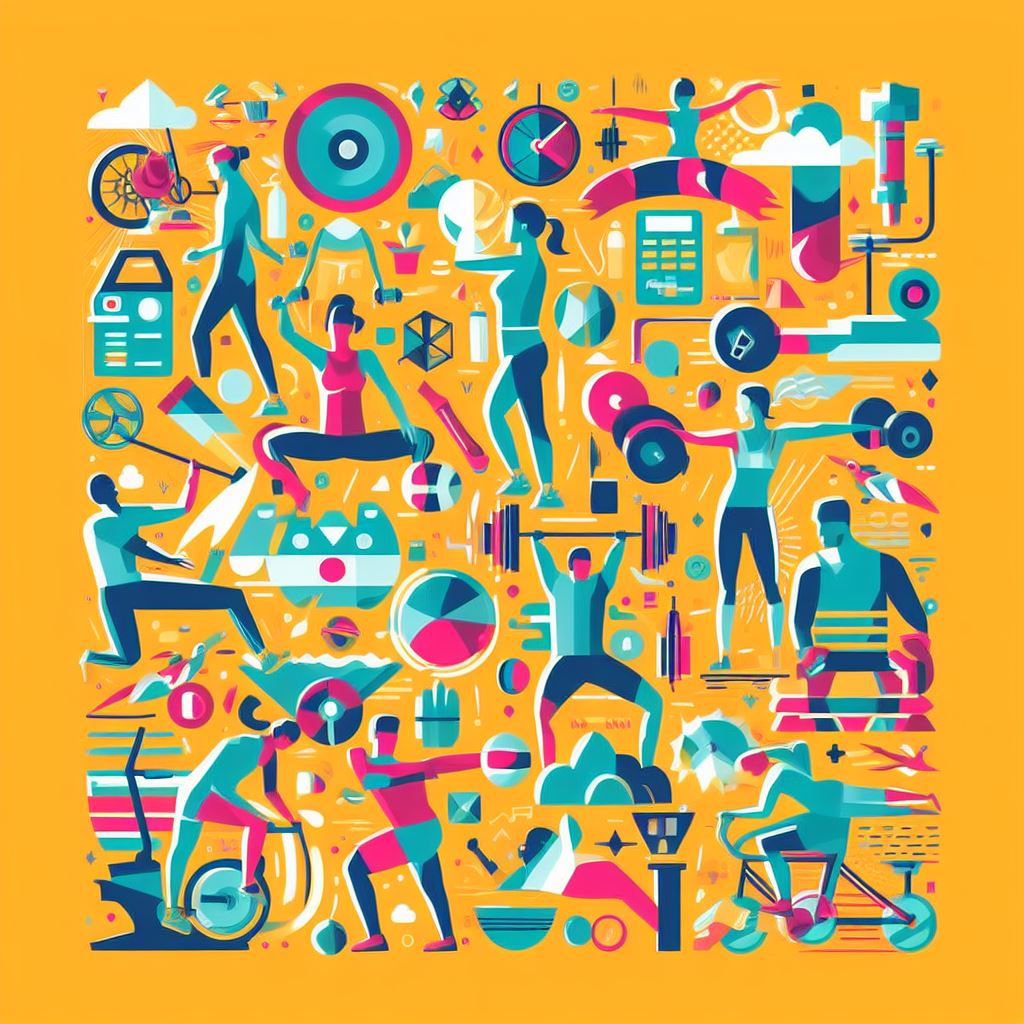Contents
An Introduction to Fitness
Welcome to our deep dive into the dynamic world of fitness! In today’s fast-paced lifestyle, staying fit isn’t just a hobby; it’s a necessity for a balanced and healthy life. Fitness, in its broadest sense, is about more than just being able to run a mile or lift weights; it’s a holistic approach to physical and mental well-being. It’s about feeling strong, staying active, and maintaining a level of health that empowers you to live your best life.
In this article, we’re going to unpack everything fitness-related. Think of this as your go-to guide, whether you’re just starting out on your fitness journey or looking to step up your game. We’ll explore what fitness really means, the incredible benefits it brings (and we’re talking about more than just toned abs), and the diverse types of fitness regimens out there. Plus, we’ll dive into how you can tailor a fitness strategy that’s just right for YOU.
Here’s the deal: Fitness is not one-size-fits-all. What works wonders for your gym buddy might not be your cup of tea, and that’s okay! The goal is to find what fits your body, your schedule, and your lifestyle. So whether you’re a busy parent trying to squeeze in a home workout, a student balancing studies with health, or anyone in between, we’ve got you covered.
Stay tuned as we break down the nitty-gritty of fitness in a way that’s straightforward, fun, and most importantly, practical. Get ready to be inspired, motivated, and equipped with the know-how to take your fitness game to the next level!

Understanding Fitness
Physical Fitness: Definition and Key Components
Fitness is a journey, not a destination. It’s about more than just how much you can bench press or how many miles you can run. It’s a blend of multiple elements that contribute to your overall health and well-being. Let’s break it down.
Cardiovascular Endurance: This is all about how your heart, lungs, and muscles work together when you’re doing extended physical activity. Think about running, cycling, or even fast-paced walking. Improving your cardiovascular endurance means you can do these activities longer without feeling like you’re going to collapse. It’s crucial for overall heart health and stamina.
Muscular Strength and Endurance: This isn’t just about bulging biceps. Muscular strength refers to the amount of force a muscle can produce, while endurance is about how long it can do it. Regular strength training can help you with everyday tasks like lifting groceries, and it also keeps your muscles healthy as you age.
Flexibility: Often overlooked, flexibility is a game-changer. It’s about how well your muscles and joints can move through their full range of motion. Stretching, yoga, and Pilates are great for this. Being flexible helps reduce the risk of injuries and can make everyday movements easier and more comfortable.
Body Composition: This relates to the ratio of fat to lean muscle, bones, and organs in your body. It’s not just about the number on the scale; it’s about the overall balance of these components. A healthy body composition is linked to reduced risk of certain diseases like diabetes and heart conditions.
Mental and Emotional Aspects of Fitness
The physical benefits of fitness are pretty well-known, but let’s talk about your brain and your mood. Working out is a powerhouse when it comes to stress reduction. Exercise releases endorphins, those feel-good hormones that can create a natural high. This is why you often feel more upbeat and energetic after a good workout.
But it’s not just about short-term gains. Regular physical activity has been shown to improve overall mental health, reducing symptoms of depression and anxiety. It’s a stress-buster, a mood-lifter, and a confidence-booster all rolled into one. When you exercise, you’re not just working on your body, but you’re also giving your mental health a positive boost.
The Evolution of Fitness Over Time
Fitness isn’t static; it has evolved significantly over the years. If we take a trip down memory lane, ancient civilizations like the Greeks and Romans emphasized physical fitness as a crucial part of their lifestyles, linking it to the idea of perfection in both the mind and body.
Fast forward to the 20th century, and you’ll see the rise of bodybuilding and aerobics. Fitness icons like Arnold Schwarzenegger and Jane Fonda became household names, revolutionizing the way people viewed exercise. This era put a spotlight on physical fitness, making it more mainstream.
In recent decades, we’ve seen a seismic shift in how people approach fitness. It’s no longer just about lifting the heaviest weights or running the longest distance. Today’s fitness is more holistic. It’s about finding balance and integrating physical activity into a comprehensive lifestyle that also prioritizes mental and emotional well-being.
We’re seeing trends like HIIT (High-Intensity Interval Training), functional fitness, mind-body classes like yoga and Pilates, and a focus on sustainable, long-term health rather than quick fixes. Fitness technology has also made a huge leap. With wearable tech and fitness apps, personalized workout plans are at our fingertips, making fitness more accessible and tailored to individual needs.
Moreover, there’s a growing emphasis on community and group fitness. From CrossFit to running clubs, people are finding motivation and support within fitness communities. This has been a game-changer in how people view and engage with fitness.
The future of fitness looks even more personalized, with AI and virtual reality likely playing a significant role. Imagine workouts tailor-made for your body’s needs, guided by AI, and experienced in the comfort of your own home via virtual reality. The possibilities are endless!
Understanding fitness is about appreciating this multifaceted concept. It’s a combination of physical, mental, and emotional well-being that has grown and evolved over time. Whether you’re a seasoned athlete or just starting out, recognizing the various aspects of fitness can help you create a more balanced and fulfilling approach to your health and wellness journey.
Fitness, at its core, is about so much more than what many perceive. It’s a holistic approach that benefits our physical, mental, and emotional states, evolving and adapting through time to encompass a wide range of activities and benefits. Whether you’re lifting weights at the gym, joining a yoga class, or simply taking a brisk walk, you’re contributing to your overall fitness and well-being. Remember, every step counts on this journey, and understanding these various components of fitness is the key to a healthier, happier you.
Benefits of Regular Fitness Activities
Fitness isn’t just a hobby or a way to look good in a swimsuit. It’s a key component of a healthy, balanced life. But what exactly are the benefits of sticking to a regular fitness routine? Let’s dive into how regular exercise can be a game-changer for your health, mind, and social life.
Physical Health Benefits
- Disease Prevention: Regular physical activity is a powerhouse when it comes to warding off diseases. By staying active, you significantly lower your risk of chronic diseases such as heart disease, diabetes, and certain types of cancer. Exercise helps manage blood sugar levels, improve cholesterol, and reduce blood pressure, which are key factors in preventing these conditions.
- Weight Management: This one might seem obvious, but it’s worth emphasizing. Regular exercise helps you control your weight by using excess calories that would otherwise be stored as fat. But it’s not just about burning calories; it’s also about building lean muscle, which boosts your metabolism. This makes it easier to maintain a healthy weight in the long term.
- Enhanced Immunity: Regular physical activity can boost your immune system. It promotes good circulation, which allows the cells and substances of the immune system to move through the body freely and do their job efficiently. People who exercise regularly tend to get sick less often, and when they do, the intensity and duration of the illness are often reduced.
Mental Health Benefits
- Stress Relief and Mental Clarity: Exercise is a fantastic stress-buster. Physical activity increases the production of endorphins, your brain’s feel-good neurotransmitters. This not only helps relieve stress but also improves your ability to sleep, which in turn reduces stress. Moreover, focusing on a workout allows you to take a break from the daily grind, giving your mind a chance to rest and recuperate.
- Boosting Self-Esteem and Body Image: Regular fitness activities can lead to an improvement in your perception of your attractiveness and self-worth. When you exercise, you see your body achieving things, getting stronger, fitter, and healthier. This does wonders for your confidence and body image. There’s a profound sense of accomplishment that comes from meeting your fitness goals, which can uplift your overall sense of self-esteem.
Social and Lifestyle Benefits
- Community and Social Connections: One of the lesser-discussed but equally important benefits of regular exercise is the social aspect. Joining a gym, attending fitness classes, running in a local park, or even online workout groups can connect you with a community of like-minded individuals. These connections can lead to friendships, networking opportunities, and a sense of belonging, which are crucial for our mental and emotional health.
- Improvement in Sleep and Energy Levels: Regular exercise can dramatically improve the quality of your sleep. It helps you fall asleep faster and deepens your sleep. Sleeping better can improve your mood, your mental alertness, and your overall energy levels. Additionally, regular physical activity can boost your stamina and reduce feelings of fatigue, helping you feel more energized throughout the day.
Why These Benefits Matter
Understanding these benefits can be a powerful motivator. It’s not just about the immediate results like muscle gain or weight loss. It’s about investing in your long-term health and well-being. Regular physical activity has a profound impact on your overall quality of life. It keeps your body and mind in tune and can improve nearly every aspect of your health from the inside out.
Moreover, the social and lifestyle benefits of fitness activities can have a ripple effect on other areas of your life. From enhancing your social life to improving your sleep and boosting your mood, the benefits extend far beyond the physical.
Incorporating Fitness into Your Life
Now, knowing these benefits is one thing, but incorporating regular fitness into your life is another. It’s important to find activities that you enjoy. If you dread your workouts, it’s going to be tough to stick with them. Experiment with different types of activities – be it team sports, individual workouts, outdoor activities, or gym classes – until you find what you love.
Remember, consistency is key. It’s better to work out a little every day than to have an intense session once in a while. Start small, set realistic goals, and gradually build up your fitness level. Listen to your body and give it time to rest and recover when needed.
And don’t forget to celebrate your achievements, no matter how small. Each step forward is a step towards a healthier, happier you. Regular fitness isn’t just a journey towards better physical health, but a holistic path to a better quality of life.
The benefits of regular fitness activities are vast and multi-faceted, touching every aspect of your life. From physical and mental health to social and lifestyle advantages, regular exercise is a cornerstone of a healthy, happy life. It’s about feeling good, inside and out, and building a foundation for a fulfilling, vibrant life. So, lace up those sneakers, hit the gym, or unroll that yoga mat – your body, mind, and social life will thank you!

Types of Fitness Regimens
Embarking on a fitness journey is like standing at a buffet of endless options. It’s exciting but can also be overwhelming. The key is to understand what’s on offer and then pick what suits your taste, or in this case, your body and goals. Let’s explore the various types of fitness regimens you can incorporate into your routine.
Cardiovascular Training
- Running, Swimming, Cycling: These are the classics when it comes to cardio. Running, swimming, and cycling are fantastic ways to improve cardiovascular health, burn calories, and increase stamina. Whether it’s hitting the pavement, swimming laps in a pool, or cycling through scenic routes, these activities can be easily adapted to your fitness level and are great for boosting endurance.
- High-Intensity Interval Training (HIIT): HIIT is all about short bursts of intense exercise followed by brief periods of rest or lower-intensity exercise. This type of training gets your heart rate up and burns more fat in less time. It’s efficient, dynamic, and can be tailored to various fitness levels. HIIT sessions can include a mix of cardio exercises, like sprints and jump squats, and are perfect for those with a busy schedule.
Strength Training
- Weight Lifting: Lifting weights isn’t just for bodybuilders. It’s a key part of building muscle, strengthening bones, and boosting metabolism. Whether you’re using dumbbells, barbells, or kettlebells, weight lifting can be adapted to suit beginners and advanced athletes alike.
- Bodyweight Exercises: No equipment? No problem. Bodyweight exercises like push-ups, pull-ups, and squats use your own weight to build strength. They’re versatile, effective, and can be done just about anywhere.
- Resistance Band Workouts: Resistance bands are a great tool for strength training. They add an extra challenge to bodyweight exercises and are gentle on the joints. Plus, they’re portable, making them ideal for home workouts or for staying fit on the go.
Flexibility and Mobility Workouts
- Yoga: More than just stretching, yoga is about balance, strength, and flexibility. It’s a holistic approach to fitness that combines physical postures, breathing techniques, and meditation. Yoga is known for its ability to reduce stress and improve overall physical and mental well-being.
- Pilates: Pilates focuses on small movements that require the use of important stabilizing muscles of the back and core. It’s excellent for improving posture, flexibility, and muscular endurance. Pilates can be done with or without equipment and is a great way to strengthen your body as a whole.
- Stretching Routines: Regular stretching is essential for maintaining flexibility and range of motion. It helps prevent injuries and can relieve post-workout aches and pains. Incorporating stretching into your routine, whether it’s dynamic stretching as a warm-up or static stretching to cool down, is vital for a balanced fitness regimen.
Specialized Fitness Programs
- CrossFit: CrossFit is a high-intensity fitness program that incorporates elements from several sports and types of exercise. It’s known for its community aspect and its focus on functional movements performed at high intensities. Think of it as a diverse workout that can include sprinting, rowing, jumping rope, weightlifting, and a variety of bodyweight exercises.
- Dance-based Workouts: Who says fitness can’t be fun? Dance-based workouts are an excellent way to get your heart pumping. From Zumba to hip-hop dance to ballet-inspired barre classes, these workouts combine music, rhythm, and movement for a full-body workout that’s both effective and enjoyable.
- Martial Arts: Martial arts like karate, judo, or Brazilian jiu-jitsu are not just about self-defense. They’re comprehensive fitness programs that improve flexibility, strength, endurance, and mental discipline. They also provide a unique way to develop self-confidence and resilience.
Tailoring Your Fitness Regimen
Now that you’re familiar with the different types of fitness regimens, how do you pick what’s right for you? The answer lies in understanding your personal fitness goals, preferences, and body’s needs. Most fitness experts recommend a combination of different types of training to achieve a well-rounded fitness level. For instance, you could combine strength training with yoga to ensure you’re building muscle while maintaining flexibility.
It’s also important to listen to your body and adjust your fitness regimen as needed. What works for you now might change as you progress in your fitness journey. And remember, variety not only keeps things interesting but can also prevent overuse injuries and improve your overall fitness.
The world of fitness is diverse and expansive. Whether you prefer the solitude of a long run, the intensity of a HIIT session, the focused strength-building of weight lifting, or the mindful stretching of yoga, there’s something for everyone. Each type of fitness regimen offers its unique benefits and challenges, making it crucial to explore and find what works best for you. Remember, the best workout is the one that you enjoy and can stick to consistently. Happy sweating!
Choosing the right fitness regimen is like picking the perfect ingredients for a delicious meal. It requires understanding the options, knowing your taste, and sometimes a bit of experimentation. So go ahead, mix and match these fitness activities to create a routine that keeps you excited, motivated, and moving towards your health and fitness goals. Your journey towards a healthier, fitter, and happier you starts with taking that first step. Let’s get moving!
Personalizing Your Fitness Journey
One size does not fit all, especially in the world of fitness. A personalized approach is essential for achieving and maintaining your fitness goals. In this section, we will delve into how to tailor your fitness journey to your unique needs, including understanding your body type, aligning your diet with your fitness goals, and overcoming common challenges.
Understanding Your Body Type and Fitness Goals
- Endomorph, Mesomorph, Ectomorph: Each body type has its own set of characteristics. Endomorphs usually have a larger, more solid frame and may struggle to lose weight. Mesomorphs often have a muscular build and can gain or lose weight relatively easily. Ectomorphs are typically lean and may find it hard to gain weight or muscle. Recognizing your body type can help tailor your fitness and nutrition plan to what works best for your physique.
- Setting Realistic and Measurable Goals: It’s important to set goals that are both achievable and measurable. Instead of aiming to “lose weight,” set a goal to “lose 10 pounds in 3 months.” This gives you a clear target and timeframe. Remember to consider your body type, lifestyle, and other factors when setting these goals. Setting unrealistic expectations can lead to disappointment and demotivation.
Nutrition and Fitness
- Role of Diet in Fitness: Your diet is as crucial as your workout plan. It’s about fueling your body with the right nutrients to support your fitness goals. A balanced diet can help you lose fat, build muscle, increase energy levels, and recover faster. Remember, you can’t out-exercise a bad diet.
- Nutritional Plans for Different Fitness Goals: Your nutritional needs vary depending on your fitness goals. If you’re looking to build muscle, your body needs more protein. For weight loss, a calorie deficit is key, but it should be done healthily. Seek professional advice if necessary to ensure your diet aligns with your goals without compromising your health.
Overcoming Common Challenges
- Time Management: Finding time for fitness in a busy schedule is a common challenge. The key is to prioritize and plan. You don’t necessarily need hours; even 30 minutes can be effective if used wisely. Try high-intensity interval training (HIIT) for a quick yet effective workout, or incorporate physical activities into your daily routine, like biking to work.
- Injury Prevention and Recovery: Injuries can significantly set back your fitness journey. Proper form, gradual progression in intensity, and adequate warm-up and cool-down routines are crucial for injury prevention. If you do get injured, focus on recovery. Rest, appropriate exercises, and possibly consulting a professional are essential steps in healing and getting back on track.
- Staying Motivated: Motivation ebbs and flows. To stay motivated, set short-term goals that lead to your long-term objective. Mix up your routine to keep it interesting, track your progress, and don’t be too hard on yourself. Remember, progress, not perfection, is key.
Tailoring Fitness to Your Life
Every fitness journey is unique, and what works for one person might not work for another. It’s about finding what resonates with your body, lifestyle, and preferences. Listen to your body and make adjustments as needed. It’s perfectly okay to take a step back, reassess, and try a different approach if something isn’t working.
Personalizing your fitness journey is about understanding and working with your body, not against it. It involves aligning your fitness and nutritional plan with your specific goals and overcoming common challenges through smart strategies and a positive mindset. Remember, this is your journey, unique to you. Embrace it, enjoy it, and celebrate every step towards your healthier self.
Your personalized fitness journey is not just about achieving your goals, but about enjoying the path you take to get there. By understanding your body, aligning your nutrition, and overcoming challenges, you’re setting yourself up for success. So, go ahead, tailor your fitness plan, and embark on this rewarding journey towards health and wellness. Remember, the best plan is the one that fits you perfectly. Let’s get fit, at your own pace, on your own terms!
Incorporating Technology in Fitness
In the dynamic world of fitness, technology has emerged as a game-changer, revolutionizing how we approach our workouts and overall health. From tracking our every step to connecting us with global fitness communities, technology has brought about a new era in fitness.
Fitness Trackers and Apps
Fitness trackers and apps are like having a personal trainer and health coach right in your pocket or on your wrist. These devices and applications do much more than just count steps or track calories. They monitor heart rate, analyze sleep patterns, track specific workouts, and even provide personalized recommendations. For instance, many fitness watches now come with built-in GPS to track your runs, heart rate monitors to gauge exercise intensity, and even reminders to move if you’ve been sedentary for too long.
The real power of these gadgets lies in their ability to keep us accountable and provide tangible data on our progress. Whether you’re training for a marathon or trying to lose weight, being able to see your daily activity levels, monitor your heart rate, and track your sleeping patterns can be incredibly motivating. These tools make it easier to set goals, track progress, and stay committed to a healthier lifestyle.
Virtual and Augmented Reality in Workouts
Virtual and Augmented Reality (VR and AR) are taking fitness to an entirely new level. Imagine cycling through the French Alps or running the streets of Tokyo, all from the comfort of your home. VR workouts can transport you to different environments, making your workouts more engaging and enjoyable.
AR, on the other hand, overlays digital information onto the real world, enhancing your workout experience. Apps using AR can project animated coaches into your living room who guide you through a workout, or show you how to perform exercises correctly, adding an interactive dimension to home workouts.
Online Fitness Communities and Resources
One of the most significant impacts of technology in fitness is the creation of vast online communities and resources. These platforms provide an abundance of information, from workout routines to nutrition advice, and create spaces where people can share their fitness journeys, challenges, and successes.
Online fitness communities, like those found on social media or dedicated fitness apps, offer support, motivation, and a sense of belonging, which can be incredibly empowering. Whether you’re a beginner or a seasoned athlete, these communities make it easy to find advice, get inspired, and connect with like-minded individuals.
The integration of technology in fitness has opened up new avenues for achieving our health and fitness goals. It offers personalized data, innovative workout experiences, and a global support system, all contributing to a more informed, enjoyable, and effective fitness journey. Whether you’re using a fitness tracker, immersing yourself in a VR workout, or engaging with an online community, technology is an invaluable asset in our quest for health and well-being.
Embracing technology in our fitness routines offers a unique blend of convenience, motivation, and personalized guidance. It’s about enhancing our experience and effectiveness, transforming the way we approach our health and fitness. So, whether you strap on a fitness tracker, dive into a virtual workout, or join an online fitness challenge, remember that technology is there to support and enrich your fitness journey. Let’s make the most of these innovative tools and stride towards our fitness goals with confidence and excitement!
Future of Fitness
We’re always excited to explore what the future holds for the fitness industry. It’s a space that’s continually evolving, driven by technology, science, and changing lifestyle trends. Let’s dive into some emerging trends and predictions, and understand how AI, machine learning, and sustainability are shaping the future of fitness.
Emerging Trends and Predictions
The future of fitness is looking more personalized, tech-driven, and holistic. One key trend is the rise of at-home workouts, accelerated by recent global events. This shift has led to an increase in online fitness programs, live streaming workout sessions, and a surge in sales of home gym equipment. Another emerging trend is the integration of wellness and mental health into fitness routines. People are increasingly recognizing the link between physical activity and mental well-being, leading to a rise in yoga, mindfulness, and other wellness-oriented practices.
There’s also a growing emphasis on recovery as an essential part of fitness. Techniques like cryotherapy, foam rolling, and infrared saunas are becoming more mainstream, highlighting the importance of rest and recovery in any fitness regime.
The Role of AI and Machine Learning in Personal Fitness
Artificial Intelligence (AI) and machine learning are at the forefront of personalizing fitness experiences. AI-driven platforms can now provide custom workout and nutrition plans based on individual data, preferences, and performance. These systems learn from your activities and adapt over time, offering more tailored advice and support.
We’re also seeing AI in wearable technology, where it helps in more accurate tracking and analysis of health metrics like heart rate, sleep patterns, and exercise intensity. This data can then be used to provide insights and recommendations, enhancing the effectiveness of workout plans.
Sustainability in Fitness Practices
Sustainability is becoming a critical focus in the fitness world. There’s a growing awareness about the environmental impact of fitness gear, leading to a rise in eco-friendly products, from biodegradable yoga mats to recycled-fabric gym wear.
Fitness facilities are also adopting sustainable practices, like using energy-efficient equipment and sourcing local, sustainable products. Furthermore, there’s an emphasis on outdoor activities, which not only reduces the reliance on electricity-consuming equipment but also connects people with nature, enhancing mental wellness.
The future of fitness is shaping up to be more personalized, tech-driven, and aligned with overall well-being and sustainability. As these trends evolve, they offer exciting opportunities to make our fitness journeys more effective, enjoyable, and in tune with our values. Embracing these changes, we can look forward to a future where fitness is not just about physical health but encompasses a holistic approach to our well-being.
The fitness landscape is ever-evolving, with each new trend and technological advancement bringing us closer to more personalized, effective, and sustainable practices. Whether it’s the adoption of AI for tailored fitness plans or the shift towards eco-friendly practices, the future of fitness promises to enhance our approach to health and wellness in profound ways. Let’s embrace this exciting journey, keeping ourselves open to new ideas and innovations that not only elevate our fitness routines but also contribute to our overall well-being and the health of our planet.

Conclusion
As we wrap up this comprehensive journey through the multifaceted world of fitness, let’s take a moment to recap the key points that we’ve explored. We started by understanding fitness in its entirety, covering its physical, mental, and emotional aspects. We then delved into the incredible benefits of regular fitness activities, emphasizing not just the physical health perks but also the profound impact on mental well-being and social connections.
Our exploration took us through the diverse types of fitness regimens, highlighting that there’s something for everyone – from cardiovascular and strength training to flexibility workouts and specialized programs like CrossFit or dance-based workouts. We then navigated the personalization of fitness, understanding the importance of aligning workouts with individual body types, goals, and nutritional needs, while addressing common challenges like time management and staying motivated.
Incorporating technology emerged as a significant aspect of modern fitness, offering tools for enhanced engagement and efficiency. Finally, we looked into the future, anticipating a more personalized, tech-integrated, and sustainability-focused fitness landscape.
We encourage everyone to adopt a holistic approach to fitness. It’s not just about the physical aspect but also about nurturing your mental and emotional well-being. Fitness should be a sustainable part of your lifestyle – something you enjoy and look forward to, not a chore. Remember, the goal is to find a routine that fits seamlessly into your life, one that you can maintain long-term and that contributes to your overall happiness and health.
Embrace the journey of fitness with an open mind and heart. Experiment, find what works for you, and most importantly, have fun with it. Fitness is a personal journey, one that’s as unique as you are. Here’s to making fitness a joyous, rewarding, and integral part of your everyday life!
Embracing fitness is about more than just hitting the gym or counting calories; it’s about creating a balanced, sustainable lifestyle that nourishes your body, mind, and soul. So, find your rhythm, explore new trends, embrace technology, and most importantly, listen to your body. Your fitness journey is a personal adventure – one that should bring joy, vitality, and a sense of fulfillment into your life. Let’s celebrate our individual journeys and keep pushing towards a healthier, happier us!


